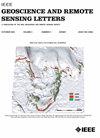基于偏振散射矩阵估计的昆虫定向精确提取
IF 4
3区 地球科学
Q2 ENGINEERING, ELECTRICAL & ELECTRONIC
引用次数: 21
摘要
提出了一种基于目标偏振散射矩阵(PSM)估计的昆虫方位提取方法,该方法既适用于传统的非相干接收垂视昆虫雷达,也适用于相干雷达。雷达极化平面上不同偏振方向的昆虫回波信号通常采用旋转线极化天线获取。本文首先利用昆虫回波信号,采用基于二阶多项式近似的迭代算法对昆虫PSM进行精确估计。同时,对Cramer-Rao下界进行了分析,检验了估计的性能。其次,在假设目标方向与优势特征向量一致的前提下,从估计的PSM中提取昆虫方向。最后,通过理论仿真和实际实验数据验证了所提方法的有效性和可行性,在低信噪比的情况下获得了较好的定向估计精度。本文章由计算机程序翻译,如有差异,请以英文原文为准。
Accurate Insect Orientation Extraction Based on Polarization Scattering Matrix Estimation
A novel insect orientation extraction method is proposed based on the target polarization scattering matrix (PSM) estimation, which is applicable for traditional vertical-looking insect radar with noncoherent reception as well as the coherent radar. The insect echo signal at different polarization directions on the radar polarization plane is usually acquired by means of rotating linearly polarized antenna. In this letter, the insect echo signal is first used to accurately estimate insect PSM by an iterative algorithm based on the second-order polynomial approximation. Meanwhile, the Cramer–Rao lower bound is also analyzed to test the estimation performance. Next, based on the assumption that the target orientation is consistent with the dominant eigenvector, the insect orientation is extracted from the estimated PSM. Finally, both theoretical simulations and real experimental data are used to validate the effectiveness and feasibility of our proposed method, which can achieve good orientation estimation accuracy at low signal-to-noise ratio.
求助全文
通过发布文献求助,成功后即可免费获取论文全文。
去求助
来源期刊

IEEE Geoscience and Remote Sensing Letters
工程技术-地球化学与地球物理
CiteScore
7.60
自引率
12.50%
发文量
1113
审稿时长
3.4 months
期刊介绍:
IEEE Geoscience and Remote Sensing Letters (GRSL) is a monthly publication for short papers (maximum length 5 pages) addressing new ideas and formative concepts in remote sensing as well as important new and timely results and concepts. Papers should relate to the theory, concepts and techniques of science and engineering as applied to sensing the earth, oceans, atmosphere, and space, and the processing, interpretation, and dissemination of this information. The technical content of papers must be both new and significant. Experimental data must be complete and include sufficient description of experimental apparatus, methods, and relevant experimental conditions. GRSL encourages the incorporation of "extended objects" or "multimedia" such as animations to enhance the shorter papers.
 求助内容:
求助内容: 应助结果提醒方式:
应助结果提醒方式:


